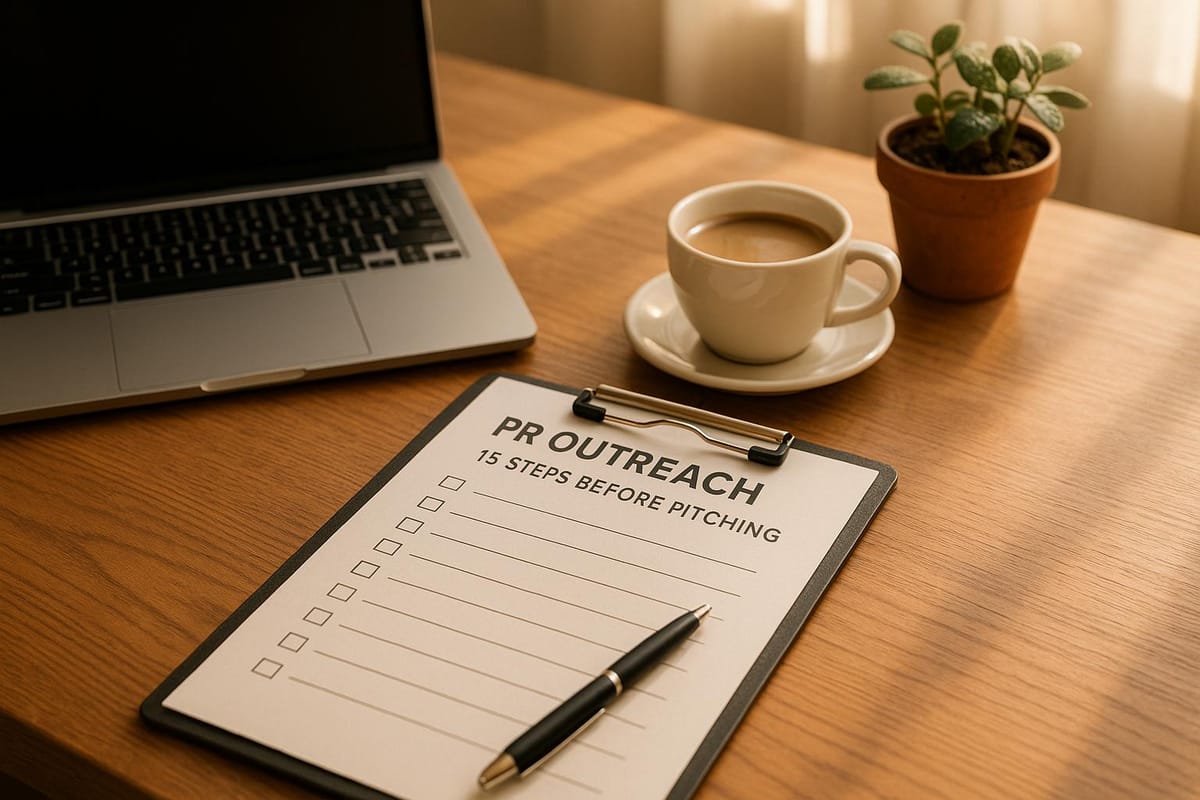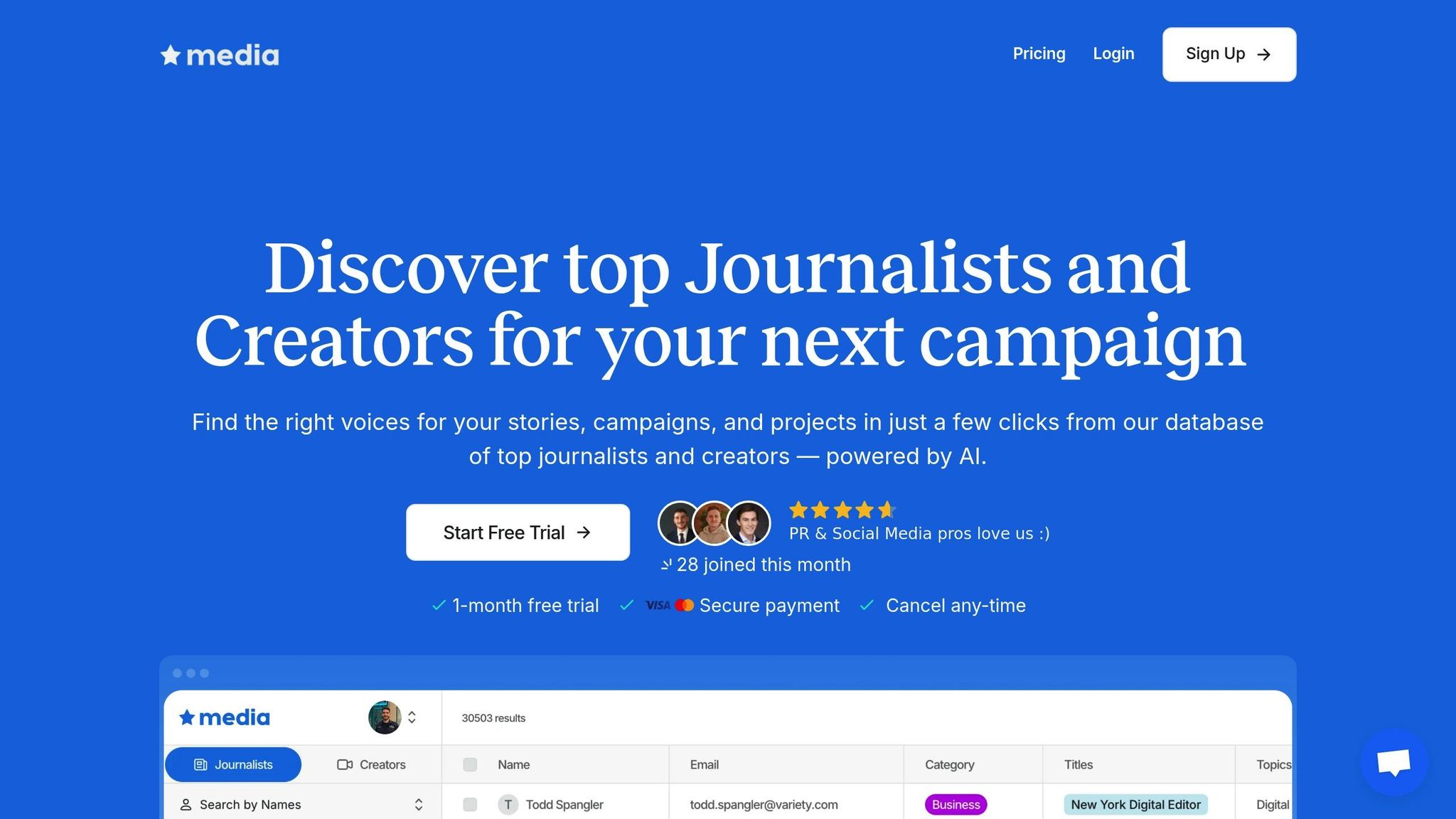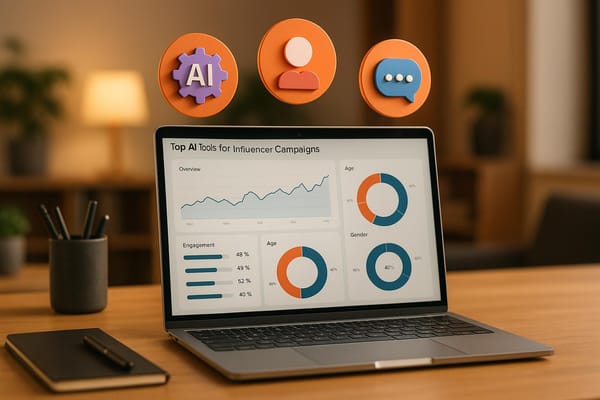PR Outreach Checklist: 15 Steps Before Pitching
Master the art of PR outreach with this comprehensive checklist, ensuring your pitches are personalized, targeted, and effective.

Sending poorly-prepared pitches is a waste of time and can harm your reputation. A well-structured PR outreach plan increases your chances of success by targeting the right journalists with personalized, relevant pitches. Here’s a quick breakdown of the process:
- Set Clear Goals: Define measurable objectives and identify your target audience.
- Find the Right Journalists: Use tools like Media AI to research journalists covering your niche.
- Prepare Press Materials: Create a press kit with press releases, visuals, and fact sheets.
- Personalize Pitches: Reference journalists' recent work and tailor your message.
- Track Results: Monitor metrics like open rates and media coverage to measure success.
The key takeaway? Preparation and personalization are non-negotiable for effective PR outreach.
Tips & Strategies For Doing Your Own PR Outreach
15-Step PR Outreach Checklist
If you want to nail your PR outreach, preparation is everything. This 15-step checklist will guide you through the process, helping you turn your pitches into media coverage instead of letting them get lost in inboxes.
Set Clear Campaign Goals and Target Audience
Start by setting specific, measurable goals for your campaign. For example, aim for three tech feature articles in 30 days instead of vague objectives. Then, build detailed audience profiles by considering demographics, interests, and media habits.
Next, establish a timeline that accounts for journalists' schedules and publication deadlines. Finally, map out 3–5 core talking points so you can quickly match your story to the right reporters and outlets.
Once you’ve nailed down your goals and audience, it’s time to find the people who can help tell your story.
Find the Right Journalists and Influencers
Use Media AI's database to sift through over 30,000 journalists and influencers. Filter results by beat, location, publication, or recent topics to zero in on those covering your industry.
Research their recent work to get a sense of their style, preferred angles, and sources. This helps you tailor your pitch to their interests.
Double-check contact details to ensure they’re still active in their roles. Media AI keeps its database current, but it’s always smart to confirm via LinkedIn or recent bylines.
Evaluate engagement levels when targeting influencers. Don’t just look at follower counts - check for meaningful interactions like comments and shares. Authentic engagement beats raw numbers every time.
Assess alignment by reviewing their past coverage and social media presence. Make sure their values and tone align with your brand to avoid any mismatched messaging.
Prepare Your Press Materials
Build a press kit that includes everything journalists might need: a press release, company background, executive bios, high-resolution images, and key data or research. Keep it all in a shared folder for easy access.
Tailor your press release for different audiences. For instance, a tech outlet might want technical details, while a business publication would lean toward market impact.
Gather visuals like professional headshots, product photos, infographics, and charts. Ensure they’re formatted for both print and digital use.
Prepare quote sheets with pre-approved statements from executives, customers, or industry experts. This makes it easy to provide commentary when journalists need it.
Create fact sheets with key stats, milestones, and industry context. Double-check all data for accuracy and include sources.
With these materials ready, you’ll be equipped to craft pitches that stand out.
Write Personalized Pitches Using AI Tools
Use Media AI's pitch assistance to craft personalized messages. Reference each journalist’s recent work and tailor your pitch to their interests.
Write attention-grabbing subject lines that tie your story to their recent articles or industry trends. Avoid generic phrases like "Great Opportunity" - be specific and relevant.
Keep it concise. Your main hook should be in the first paragraph. Journalists are busy, so get to the point quickly and save the details for follow-ups or attachments.
Highlight your credentials. Explain why you’re a credible source - mention your expertise, company background, or unique perspective.
End with a clear call-to-action. Offer something specific, like a quick interview or additional data, to make it easy for them to respond.
Set Up Tracking and Success Metrics
Define KPIs that match your goals, such as email open rates, response rates, secured interviews, published articles, and social media mentions. Use past campaigns or industry benchmarks as a reference.
Use tracking tools to monitor email opens, clicks, and responses. Set up Google Alerts for your brand, executives, and key terms to catch media mentions.
Track media coverage across both online and print platforms. Alerts for your company name, product names, and industry keywords can help you spot mentions you might otherwise miss.
Build relationships. Note which journalists engage with your pitches or request more info. These contacts are valuable and should be prioritized in your CRM.
Measure long-term results. Look at how media coverage impacts business metrics like leads, awareness, or sales inquiries. This data not only justifies your PR spend but also helps improve future campaigns.
Best Practices for Outreach and Follow-Up
Getting PR right isn’t just about crafting a compelling pitch - it’s also about reaching out through the right channels and handling follow-ups with care.
Pick the Best Communication Method
Email is the go-to option for most PR outreach, but it’s not a one-size-fits-all solution. Some journalists might prefer a quick Twitter DM for breaking news tips, while others respond better to phone calls, especially for urgent stories.
The key is to do your homework. Check journalists’ social media bios for clues about their preferred contact methods. Tailor your approach accordingly: keep Twitter DMs short and to the point, craft concise LinkedIn messages, and save detailed pitches for email.
If you’re using tools like Media AI, you can filter contacts by beat, location, and other criteria to fine-tune your outreach.
Social media works best for building relationships rather than pitching cold. Follow journalists who cover your industry, engage with their posts thoughtfully, and share relevant insights or data. This way, when you send a formal pitch, your name won’t feel like it’s coming out of nowhere. Reserve phone calls for time-sensitive updates or when you’ve already established some rapport - unsolicited calls can feel intrusive, especially when deadlines are looming.
Once you’ve chosen the right communication channel, plan your follow-ups strategically to keep the conversation alive.
Follow Up Without Being Annoying
Timing matters when it comes to follow-ups. Research shows that sending follow-ups can boost response rates by as much as 40%.
Here’s a general timeline to follow:
- Send your first follow-up 2–3 days after the initial pitch.
- Wait 5–7 days for the next attempt.
- Space additional follow-ups 1–2 weeks apart, and limit yourself to 3–5 follow-ups total.
Most responses for digital PR - about 69.4% - come within the first 6 hours, and 88.6% arrive within 2 days. So, don’t bombard journalists but give them enough time to respond.
Each follow-up should add something new. Share updated data, offer a fresh angle, or tie your pitch to a timely event. This shows you’re genuinely trying to provide value, not just pushing your agenda.
Persistence, when done respectfully, can make a difference. While over 40% of sales professionals give up after just one follow-up, sticking with it (within reason) can pay off.
Be mindful of time zones and work schedules when sending follow-ups. A poorly timed message can give the impression that you didn’t do your research.
And remember, silence doesn’t always mean rejection. As Collin Czarnecki, Owner of Noble, puts it:
"As a former journalist, I can tell you firsthand that I rarely responded to pitches, unless I needed additional data or expert commentary to elevate my reporting".
Sometimes, journalists are just busy. If you’ve made a few attempts with no response, it’s time to pivot. Move the journalist to a long-term relationship-building list instead of continuing to pitch them. Keep engaging with their work on social media and revisit them with a fresh story angle in a few months.
How to Use Media AI in Your PR Process

Incorporating Media AI into your PR strategy ensures that every step of your outreach is handled effectively and with precision. By integrating data-driven tools, Media AI simplifies PR research, making your pitches more targeted and relevant. It builds upon your preparation efforts by ensuring that every outreach is supported by up-to-date, actionable data.
With a database of over 30,000 journalists and creators, Media AI provides real-time contact details and in-depth profiles. These profiles highlight each journalist's beat, interests, and preferred angles for stories. Plus, the platform continuously updates this information, so your outreach always stays fresh and accurate.
Media AI Features That Boost PR Efforts
Media AI offers advanced tools like filtering and AI-powered personalization, allowing you to identify the right contacts based on industry, location, or specific beats. It also tailors pitches to match each journalist's unique style. In fact, research shows that 54% of PR professionals already use AI to craft media pitches. One campaign that utilized AI-personalized pitches saw a 73% increase in replies by aligning topics with journalists’ beat preferences.
The platform also makes it simple to export data. You can seamlessly transfer curated contact lists into your preferred outreach tools, saving time and effort.
Other standout features include sentiment analysis and trend identification. These tools help you time your pitches perfectly by uncovering emerging narratives and trending topics, ensuring your stories feel timely and resonate with your audience.
Media AI vs. Manual Research Methods
When compared to traditional methods, Media AI offers clear advantages. It’s not just faster - it’s smarter. AI-driven research can cut influencer-vetting time by up to 70%, and teams using AI tools experience 37% higher engagement compared to those relying solely on manual research.
Accuracy is another area where Media AI excels. AI sentiment tools boast an 89% accuracy rate, far outpacing the 67% accuracy of older, manual methods. Manual research often overlooks subtle shifts in a journalist’s focus or recent beat changes. In contrast, Media AI continuously analyzes millions of articles and social media posts, keeping profiles comprehensive and up to date.
Cost efficiency is another major benefit, especially for agencies managing multiple campaigns. For instance, Hard Numbers agency used AI-driven sentiment analysis to track over 50,000 mentions daily, saving more than 300 hours each month compared to traditional tools. These time savings directly translate into lower costs and higher profitability.
AI also excels in detecting potential threats quickly. It identifies risks 83% faster than human teams. A great example is United Airlines, which used AI monitoring to reduce its reputation recovery time by 40%. Their system scanned more than 500 news sources and social platforms, detecting negative sentiment shifts in just 2.1 minutes, compared to 12.4 minutes with manual methods.
Finally, AI’s predictive capabilities provide strategic insights that manual methods can’t replicate. While human researchers are invaluable for understanding context and building relationships, AI stands out in recognizing patterns and processing large-scale data. By using Media AI, you equip your PR team with a tool that supports your campaign goals from start to finish.
Why Good Preparation Leads to PR Success
Thorough preparation is the backbone of any successful PR campaign. By laying the groundwork, you can transform ordinary pitches into meaningful media connections and measurable results. This kind of strategic planning is what separates effective campaigns from those that fall flat.
Journalists are bombarded with over 100 pitches every week - most of which are irrelevant and quickly discarded. That’s why generic, poorly researched pitches rarely stand a chance.
Using a systematic 15-step checklist can make all the difference. It ensures you set clear goals, target the right audience, and have all your press materials ready to go. For example, pitching a tech story to a food writer is an avoidable mistake that proper preparation eliminates. By aligning every step with your objectives, you can avoid such missteps and present a polished, professional campaign.
Tools like Media AI take this preparation to the next level. Instead of spending hours hunting for the right contacts, you can instantly filter through a database of over 30,000 journalists and creators based on their beats, locations, and interests. With up-to-date contact details and AI-driven personalization, your pitches can be tailored to match each recipient’s preferences and style. This not only increases the likelihood of a positive response but also lays the groundwork for long-term success.
Teams that embrace a structured approach see better results: higher response rates, stronger relationships with journalists, and more consistent media coverage. They avoid common mistakes like missing deadlines, targeting the wrong outlets, or neglecting follow-ups - earning the trust and respect of the media.
In PR, preparation isn’t just about getting it right today - it’s about setting the stage for sustained success, ensuring every pitch aligns with your broader goals.
FAQs
What’s the best way to personalize a PR pitch and grab a journalist’s attention?
To make your PR pitch stand out, start by diving into the journalist's recent work, their preferred topics, and the audience they cater to. This background knowledge helps you create a pitch that not only aligns with their interests but also shows you’ve done your homework.
Grab their attention with a concise and compelling subject line. In the pitch itself, focus on why your story matters and how it’s relevant to their readers. Steer clear of sending out generic, mass emails - personalized, one-on-one communication is the way to go. Adding thoughtful touches, like mentioning a specific article they’ve written or a shared interest, can go a long way in increasing your chances of getting a response.
What makes Media AI a better choice for PR outreach compared to traditional methods?
Media AI is revolutionizing PR outreach by providing tools like real-time media monitoring, sentiment analysis, and targeted journalist recommendations. These features help you reach the right audience more efficiently and with greater precision. Its AI-driven capabilities can forecast media interest and handle repetitive tasks, freeing up your time for more strategic efforts.
With streamlined workflows and quicker crisis response, Media AI makes your outreach not just faster but also more effective. This data-centric approach outperforms traditional manual methods, boosting the success and engagement of your campaigns.
What’s the best way to follow up on a media pitch without frustrating journalists?
To follow up with journalists without causing frustration, aim to send your follow-up email 24 to 48 hours after your initial pitch. This window often delivers the best results. Keep your email concise - about 100 to 150 words - by briefly summarizing your original pitch and adding any new, relevant details. Make it personal by referencing the journalist’s recent work or interests to show you’ve done your homework.
Avoid bombarding the journalist with too many follow-ups. If you don’t hear back after two attempts, it’s a good idea to move on. Instead, focus on building long-term relationships through thoughtful and meaningful communication. Being helpful and relevant, rather than overly persistent, will leave a positive impression and improve your chances of success in the future.





